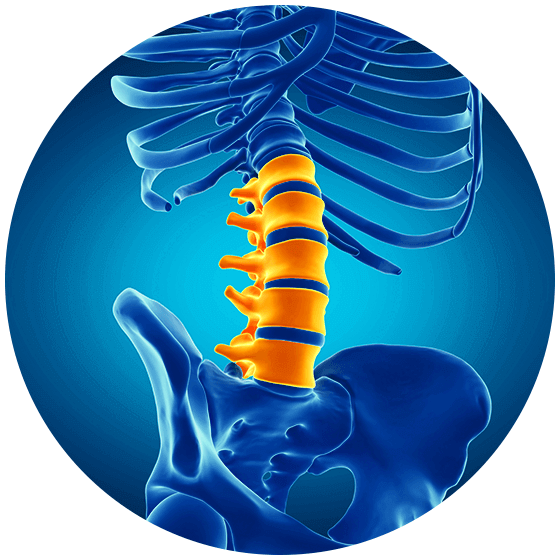Lower Back Pain

Lower Back Pain Symptoms & Treatment Options
One of the most common afflictions we deal with as we age, whether due to injury, strenuous activity, or simply spinal degeneration, is low back pain. Because of the complexity of our spines, there are several possible causes that we can link to low back pain. Fortunately, low back pain is a highly treatable condition, as it is the most common—and researched—spinal complaint.
Generally, low back pain can be traced to an array of everyday conditions that influence our spine health. Overuse, injury, and muscle strains are some of the most common causes of lower back pain. These can result from strenuous physical labor or simply from engaging in repetitive habits that damage our spine. Constant bending or twisting on the job, for example, can wear out our intervertebral discs—the tiny cushions that safeguard our spinal vertebrae from compressional forces.
There are also a wide range of spinal disorders that can lead to lower back pain. Herniated discs, spondylolisthesis (a slipped vertebra), sacroiliac joint pain, or degenerative disc disease can easily produce low back pain (aka lumbago), and these conditions are all too common in individuals as we age. When we are young, our intervertebral discs contain a gel-like fluid that permits each disc to be elastic. As we age, our discs lose their moisture content, becoming inflexible and more vulnerable to injuries such as disc herniation or spondylolisthesis.
Not sure what’s causing your lower back pain? Our team of diagnostic experts specializes in both common and obscure conditions of the spine. With over 60 years of combined experience, our orthopedic surgeons will accurately diagnose your pain and devise a personalized treatment plan that best suits your needs and active lifestyle.
The main symptoms associated with lower back pain include:
Dull, aching, or localized pain in the lower back
Pain that erupts from the lower back and shoots down the back side of either leg
Pain that interferes with movement (e.g. bending or lifting) or mobility (e.g. walking)
Discomfort or stiffness that worsens with prolonged inactivity
Position-dependent pain that worsens when making particular movements (e.g. bowing)
Pain that interferes with your sleep
Symptoms of Lower Back Pain
The symptoms of lower back pain may seem self-explanatory; however, the conditions and injuries that cause low back pain can also lead to other symptoms. All of the conditions we listed above (spondylolisthesis, osteoarthritis, etc.) are conditions that feature a wide range of symptoms. Although low back pain is often the most prevalent symptom of each disorder, that does not mean that other symptoms won’t also affect your pain or the recovery process.
However, the exact manner in which your lower back pain presents itself will depend upon the condition that is producing your discomfort. Neurological symptoms—such as tingling or numbness in the extremities, for example—are common with conditions such as herniated discs or spinal stenosis; whereas osteoarthritis, for instance, may cause joint inflammation in other regions of the body, such as the knees, elbows, or wrists. It is often the presence of these co-occurring symptoms that enable your doctor to make an accurate diagnosis of your condition.
Causes of Adult Scoliosis
There are several precipitating factors that may result in adult-onset scoliosis. Almost all of these factors are related to age and the age-related degeneration of spinal tissues and bones. One of the main reasons that we see scoliosis in adults is from exactly this: the degeneration of vertebrae and vertebral tissues due to osteoarthritis.
According to the Arthritis Association, one in two adults will experience some form of osteoarthritis in their lifetime. Osteoarthritis, most often seen in adults over age 60, involves the breaking down of cartilage between our joints. Negative side effects, such as pain or the development of bone spurs, often result. This deterioration often occurs in knees, hips, fingers, and yes, the spine. When the tissues between our vertebrae break down, it can lead to the compression of the spinal cord or spinal nerves, the growth of bone spurs, and a change in the shape of the spinal canal and the joints between our vertebrae.
Other causes of adult scoliosis include other degenerative conditions such as spinal stenosis, compression fractures, and degenerative disc disease. Like osteoarthritis, all of these conditions lead to damage of intervertebral discs, cartilage, and bone material which can result in compression of the vertebrae and nerves. This can even cause changes to the joints between our bones. Furthermore, changes in the angles between bones will change the direction of movement and the shape of the spine, possibly leading to scoliosis.
Classification of Lower Back Pain
In addition, lower back pain can be subdivided into three classifications. These include:
Lumbar Radiculopathy: This is also known as “sciatica,” and many people have it. When the sciatic nerve of the lower back becomes compressed, it can cause severe pain that radiates from the lower back and into the legs.
Axial low back pain: This is very common. The pain is confined to the lower back and travels to the buttocks or legs. The pain can be dull or sharp and severe enough to interfere with everyday activities. Physical activity or sitting in a specific position can make it worse.
Low back pain with referred pain: This is also a radiating pain in the buttocks, upper thigh, and groin. Sometimes the pain can go below the knee. Patients describe the pain as achy and dull with different intensities. The pain is very similar to axial low back pain.
Ready to schedule an appointment? At the Advanced Spine Center, it is our core belief that everyone deserves a personalized spine health plan. Our compassionate approach to serving our community hasn’t gone unnoticed: each of our surgeons has earned the distinction of Top Doctor by New Jersey Monthly Magazine. Contact us today at 973-791-4101 to schedule an appointment with one of our award-winning surgeons in patient-centered care.